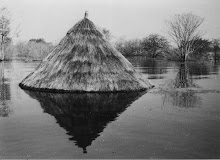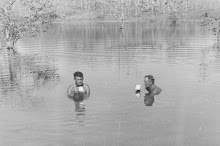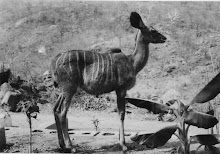As I mentioned in the previous post, my grandfather, Rupert Fothergill, owned a 16mm film camera and used it to document Operation Noah.
In the early 1960s, the Rhodesian Government used his footage to produce a documentary film consisting of four half-hour episodes telling the story of the conservation effort. This production did the rounds at schools and local theatres of the day, and may have been screened on African television once or twice, but for almost fifty years the original raw footage has sat untouched in steel canisters in a box at my parents' house in North Queensland, Australia.
 the treasure chest of Grandpa Rupert's Operation Noah films
the treasure chest of Grandpa Rupert's Operation Noah films

 a handwritten log found inside one of the cannisters
a handwritten log found inside one of the cannisters
As luck would have it, I work as a multimedia producer for a company in Brisbane. Our core business is designing and producing multimedia (mostly video) content for museums and exhibitions. This often involves the use of archival or historical film footage which needs to be digitised for use in modern video displays. We usually do this in-house with our own vintage Hanimex Eiki 16mm film projector, a piece of top quality projection screen, and a JVC HD camera. It's not true
telecine, but it does a pretty damn good job for a fraction of the price:
 the trusty Hanimex
the trusty Hanimex our set-up
our set-up
 Grandpa Rupert working with an exhausted zebra during Operation Noah
Grandpa Rupert working with an exhausted zebra during Operation Noah
(the quality of the projected image is actually much better than it seems in this photograph)
We try to rustle a bit of side-business digitising peoples' old home movies - the boxes of old 16mm or Super-8 reels that people find under the house, or in the attic at Nanna & Pop's place. We advertise our service under the (very true) warning that when old films start to smell like vinegar, they're on the fast track to irreversible damage. Where and how film has been stored will greatly effect how vulnerable it is to this decay: as with most things, warm, humid conditions are bad for preservation; cool, dry conditions are best. You can learn more
here if you're interested.
Anyway, I wasn't sure what sort of state Grandpa Rupert's films were in. I'd had a brief look over them a few months ago and they all seemed to look (and smell!) okay - but there was one cannister that had rusted shut... yesterday I prized it open with a butter knife. Oh dear:






Well and truly dead... and mum - before you start getting up me for not having done this sooner, I can assure you that this particular reel died many, many years ago!
The good news is, it appears to be the only one that has succumbed to old age. It also appears to be the only 35mm reel in the box (and therefore it's probably a nitrate based film rather than acetate based - the nitrate variety is more prone to decay), so I'm wondering whether it is in fact one of Grandpa Rupert's or whether it contains something entirely unrelated and somehow got lumped in with all the others. We'll get an expert to have a look at it and see if it's at all salvageable, but in all honesty the outlook is pretty grim.
As for the others - I've digitised three of the BIG reels (i.e.: 45mins duration each) so far, and hope to finish the rest by the weekend. Seeing the footage in all its original glory is really something! I didn't realise how faded the edited transfers were - the colour on the originals is spectacular, especially when the footage is of an exotic African parrot!
Eventually I hope to put some snippets up on to youtube, so as to give people an idea of what they contain. Stay posted...



























